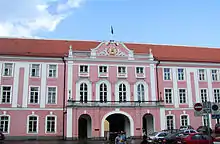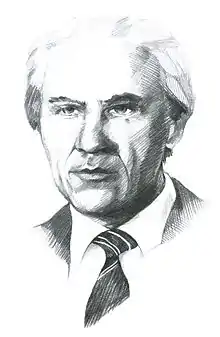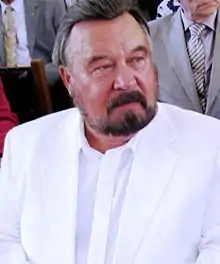Supreme Soviet of the Estonian Soviet Socialist Republic
The Supreme Soviet of the Estonian SSR (Estonian: Eesti NSV Ülemnõukogu) was the formal rubber stamp legislative body of the Estonian SSR without any substantive meaning, which was formally elected in general elections, but whose members were essentially appointed by the leadership of the Communist Party. Before 1988, the Supreme Soviet had no meaningful political role.[2] After its first democratic elections on 18 March 1990, the institution was renamed the Supreme Council of the Republic of Estonia on 8 May 1990.[Note 1]
Supreme Soviet of the Estonian SSR | |
|---|---|
 | |
| Type | |
| Type | |
| History | |
| Established | 1940 (First Soviet occupation) 1944 (1947) (Second Soviet occupation) |
| Disbanded | 1941 (German occupation) 1992 |
| Preceded by | Riigikogu |
| Succeeded by | Riigikogu |
| Elections | |
| Sham elections (1940–1985) Direct single transferable vote (1990) | |
Last election | 1990 |
| Meeting place | |
 | |
| Toompea Castle in Tallinn, Estonia | |
Organization
The structure and formal functions of the Supreme Soviet of the Estonian SSR were copied from the Supreme Soviet of the Soviet Union. The sessions of the Supreme Soviet lasted only several days twice a year and decisions were made unanimously and without much discussion. Supreme Soviet elections were held after every four years until 1978 and were held every five years in 1978–1985.[3] The Supreme Soviet gathered in Tallinn, in the Toompea Castle building which now houses the Riigikogu.
Chairmen of the Supreme Soviet
| Portrait | Chairman | From | To |
|---|---|---|---|
| Voldemar Sassi | 25 August 1940 | 1941 | |
| August Kründel | 5 March 1947 | 14 January 1953 | |
| Joosep Saat | 5 April 1955 | 23 April 1959 | |
| Harald Ilves | 23 April 1959 | 18 April 1963 | |
 |
Vaino Väljas | 18 April 1963 | 20 April 1967 |
 |
Arnold Koop | 20 April 1967 | 18 December 1968 |
| Ilmar Vahe | 18 December 1968 | 4 July 1975 | |
| Johannes Lott | 4 July 1975 | 13 December 1978 | |
| Jüri Suurhans | 13 December 1978 | 5 July 1982 | |
| Matti Pedak | 5 July 1982 | 27 March 1985 | |
| Valde Roosmaa | 27 March 1985 | 18 May 1989 | |
| Enn-Arno Sillari | 18 May 1989 | 28 March 1990 | |
 |
Ülo Nugis[4] | 29 March 1990 | 6 October 1992 |
Presidents of the Presidium of the Supreme Soviet
The presidium was the permanent body of the Supreme Soviet. Its chairman was the de jure head of state of Estonian SSR.
The chairmen of the presidium were:[5]
| President | From | To | Notes |
|---|---|---|---|
| Johannes Vares | 25 August 1940 | 29 November 1946 | First President of the Presidium of the Supreme Soviet |
| Eduard Päll | 5 March 1947 | 4 July 1950 | |
| August Jakobson | 4 July 1950 | 4 February 1958 | |
| Johan Eichfeld | 4 February 1958 | 12 October 1961 | |
| Aleksei Müürisepp | 12 October 1961 | 7 October 1970 | |
| Artur Vader | 22 December 1970 | 25 May 1978 | |
| Johannes Käbin | 26 July 1978 | 8 April 1983 | |
| Arnold Rüütel | 8 April 1983 | 28 March 1990 | Last President of the Presidium of the Supreme Soviet |
Convocations
- 1st convocation (1940–1946)
- 2nd convocation (1947–1950)
- 3rd convocation (1951–1954)
- 4th convocation (1955–1959)
- 5th convocation (1959–1962)
- 6th convocation (1963–1966)
- 7th convocation (1967–1970)
- 8th convocation (1971–1975)
- 9th convocation (1975–1979)
- 10th convocation (1980–1984)
- 11th convocation (1985–1990)
- 12th convocation (1990–1992)
Notes
- The Estonian name Ülemnõukogu remained the same, but its translation into English is usually changed from this point from "Supreme Soviet" to "Supreme Council", together with the change of the official name of the country.
References
- Toy parliament until March 1990
- Toivo Miljan (2004). Historical Dictionary of Estonia. The Scarecrow Press.
- "Eesti NSV Ülemnõukogu XII koosseisu stenogrammid ; 1. kd. (Eesti NSV Ülemnõukogu stenogrammid. 12. koosseis) | Digar". www.digar.ee. Retrieved 2020-05-05.
- Chairman of the Supreme Council from 8 May 1990
- "ENSV Ülemnõukogu / EV Ülemnõukogu". Riigikogu (in Estonian). Retrieved 2020-05-05.